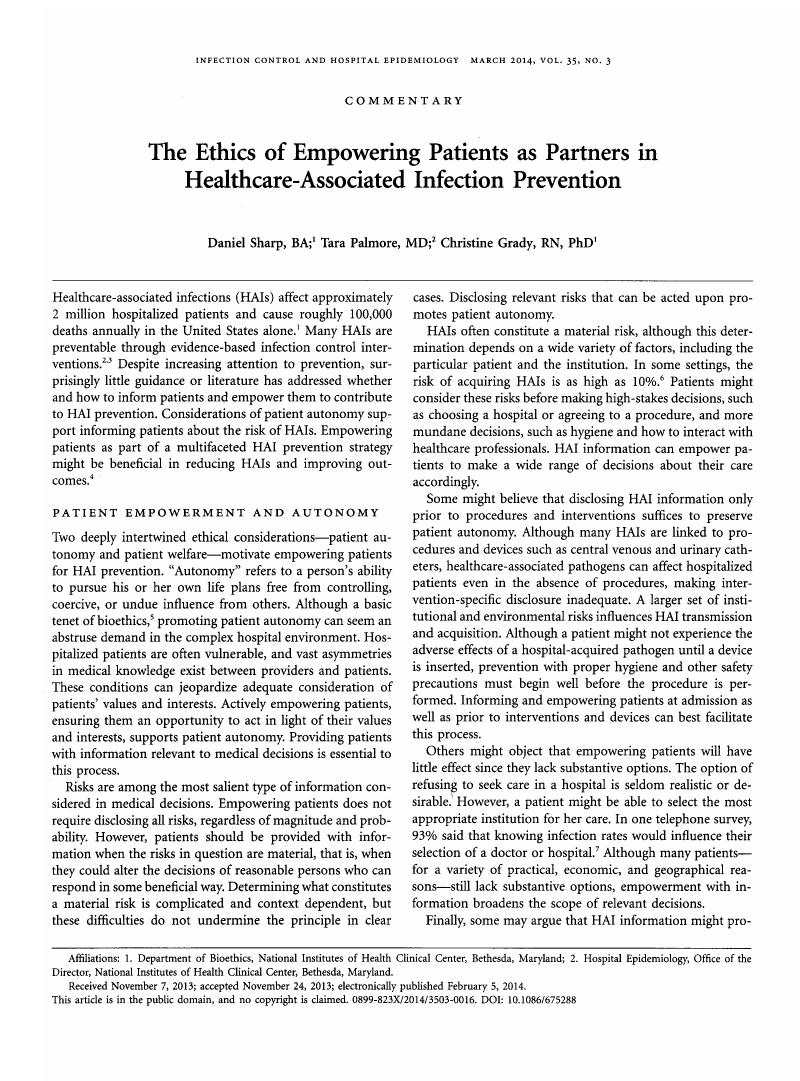Crossref Citations
This article has been cited by the following publications. This list is generated based on data provided by
Crossref.
McGuckin, Maryanne
and
Govednik, John
2014.
Patient empowerment begins with knowledge: Consumer perceptions and knowledge sources for hand hygiene compliance rates.
American Journal of Infection Control,
Vol. 42,
Issue. 10,
p.
1106.
Werner, Curt
Zimmerman, Peta-Anne
and
Elder, Elizabeth
2016.
Hospital based clearance of patients with skin and soft tissue methicillin resistant Staphylococcus aureus (MRSA): A systematic review of the literature.
Infection, Disease & Health,
Vol. 21,
Issue. 2,
p.
72.
Collier, Aileen
and
Wyer, Mary
2016.
Researching Reflexively With Patients and Families.
Qualitative Health Research,
Vol. 26,
Issue. 7,
p.
979.
Olmedo, Daniele Blasquez
Precioso, Patrícia Marraccini
Lugdero-Correia, António
Silva, Guida da
Santos, Angela Maria Guimarães dos
and
Pôrto, Luís Cristóvão
2017.
Exposure source prevalence is associated with gender in hepatitis C virus patients from Rio de Janeiro, Brazil.
Memórias do Instituto Oswaldo Cruz,
Vol. 112,
Issue. 9,
p.
632.
Palumbo, Rocco
and
Manna, Rosalba
2018.
What if things go wrong in co-producing health services? Exploring the implementation problems of health care co-production.
Policy and Society,
Vol. 37,
Issue. 3,
p.
368.
Gauthier, Jim
Calabrese, Carol
and
Teska, Peter
2020.
Targeted Moments of Environmental Disinfection.
The Joint Commission Journal on Quality and Patient Safety,
Vol. 46,
Issue. 3,
p.
167.
DeBenedictus, Christina M.
Hecker, Michelle T.
Zuccaro, Patricia D.
John, Jacob P.
Donskey, Curtis J.
and
Patel, Payal K.
2020.
What is the current state of patient education after Clostridioides difficile infection?.
Infection Control & Hospital Epidemiology,
Vol. 41,
Issue. 11,
p.
1338.
Donskey, Curtis J.
2023.
Update on Clostridioides difficile Infection in Older Adults.
Infectious Disease Clinics of North America,
Vol. 37,
Issue. 1,
p.
87.
Quintal, Ariane
Carreau, Isabelle
Grenier, Annie-Danielle
Hébert, Caroline
Yergeau, Christine
Berthiaume, Yves
and
Racine, Eric
2023.
An Ethics Action Plan for Rare Disease Care: Participatory Action Research Approach.
Journal of Participatory Medicine,
Vol. 15,
Issue. ,
p.
e46607.
Donskey, Curtis J.
2023.
Empowering patients to prevent healthcare-associated infections.
American Journal of Infection Control,
Vol. 51,
Issue. 11,
p.
A107.
Tan, Charlie
Ofner, Marianna
Candon, Heather L.
Reel, Kevin
Bean, Sally
Chan, Adrienne K.
and
Leis, Jerome A.
2023.
An ethical framework adapted for infection prevention and control.
Infection Control & Hospital Epidemiology,
Vol. 44,
Issue. 12,
p.
2044.
Juskevicius, Luize F.
Luz, Reginaldo A.
Felix, Adriana M.da Silva
Timmons, Stephen
and
Padoveze, Maria Clara
2023.
Lessons learned from a failed implementation: Effective communication with patients in transmission-based precautions.
American Journal of Infection Control,
Vol. 51,
Issue. 6,
p.
687.
Masella, Marie-Alexia
and
Godard, Béatrice
2024.
L’empowerment en santé reproductive : vers une visée éthique des soins.
Éthique publique,
Vol. vol. 26, n° 1,
Issue. ,
Masella, Marie-Alexia
and
Godard, Béatrice
2024.
The Contribution of Empowerment to Bioethics in the Obstetric Care Context.
International Journal of Feminist Approaches to Bioethics,
Vol. 17,
Issue. 1,
p.
73.
Kwon, Jennie H.
Advani, Sonali D.
Branch-Elliman, Westyn
Braun, Barbara I.
Cheng, Vincent Chi-Chung
Chiotos, Kathleen
Douglas, Peggy
Gohil, Shruti K.
Keller, Sara C.
Klein, Eili Y.
Krein, Sarah L.
Lofgren, Eric T.
Merrill, Katreena
Moehring, Rebekah W.
Monsees, Elizabeth
Perri, Luci
Scaggs Huang, Felicia
Shelly, Mark A.
Skelton, Felicia
Spivak, Emily S.
Sreeramoju, Pranavi V.
Suda, Katie J.
Ting, Joseph Y.
Weston, Gregory David
Yassin, Mohamed H.
Ziegler, Matthew J.
and
Mody, Lona
2024.
A call to action: the SHEA research agenda to combat healthcare-associated infections.
Infection Control & Hospital Epidemiology,
Vol. 45,
Issue. 9,
p.
1023.
Chiappinotto, Stefania
Galazzi, Alessandro
Papastavrou, Evridiki
Igoumenidis, Michael
Cabe, Catherine Mc
Gastmans, Chris
Wiisak, Johanna
Stolt, Minna
Suhonen, Riitta
and
Palese, Alvisa
2025.
Blueprint of ethics content in undergraduate education: A workshop-research study.
Nursing Ethics,
